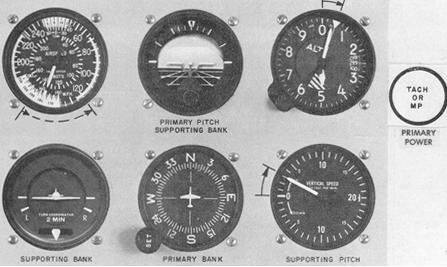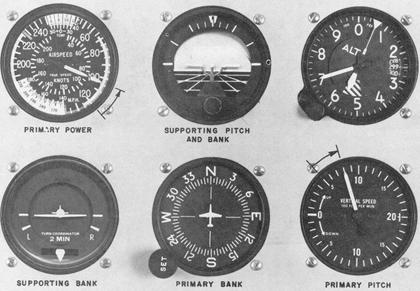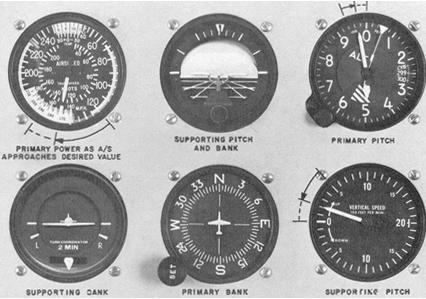
Climbs. For a given power setting and load condition, there is only one attitude that will give the most efficient rate of climb. The airspeed and the climb power setting that will determine this climb attitude are given in the performance data found in your airplane flight handbook. Details of the technique for entering a climb vary according to airspeed on entry and the type of climb (constant airspeed or constant rate) desired. (Heading and trim control are maintained as discussed under straight-and-level flight).
Entries. To enter a constant airspeed climb from cruising airspeed, raise the miniature aircraft to the approximate nose-high indication appropriate to the predetermined climb speed. The attitude will vary according to the type airplane you are flying. Apply light back elevator pressure to initiate and maintain the climb attitude. The pressures will vary as the airplane decelerates. Power may be advanced to the climb power setting simultaneously with the pitch change, or after the pitch change is established and the airspeed approaches climb speed. If the transition from level flight to climb is smooth, the vertical-speed indicator will show an immediate trend upward, continue moving slowly, and will stop at a rate appropriate to the stabilized airspeed and attitude. (Primary and supporting instruments for the climb entry are shown in Figure 5-27.)
Once the airplane stabilizes at a constant airspeed and attitude, the airspeed indicator is primary for pitch and the heading indicator remains primary for bank (Fig. 5-28). You will monitor the "Tach or MP" as the primary power instrument to ensure that the proper climb power setting is being maintained. If the climb attitude is correct for the power setting selected, the airspeed will stabilize at the desired speed. If the airspeed is low or high, make an appropriate small pitch correction.
To enter a constant airspeed climb from climb airspeed, first complete the airspeed reduction from cruise airspeed to climb speed in straight-and-level flight. The climb entry is then identical to entry from cruising airspeed, except that power must be increased simultaneously to the climb setting as the pitch attitude is increased. Climb entries on partial panel are more easily and accurately controlled if you enter the maneuver from climbing speed.
The technique for entering a constant rate climb is very similar to that used for entry to a constant airspeed climb from climb airspeed. As the power is increased to the approximate setting for the desired rate, simultaneously raise the miniature aircraft to the climbing attitude for the desired airspeed and rate of climb. As the power is increased, the airspeed indicator is primary for pitch control until the vertical speed approaches the desired value. As the vertical-speed needle stabilizes, it becomes primary for pitch control and the airspeed indicator becomes primary for power control (Fig. 5-29).
Figure 5-27. Climb entry for constant airspeed climb.
 |
Figure 5-28. Stabilized climb at constant airspeed.
 |
Pitch and power corrections must be quickly and closely coordinated. For example, if the vertical speed is correct, but the airspeed is low, add power. As the power is increased, the miniature aircraft must be lowered slightly to maintain constant vertical speed. If the vertical speed is high and the airspeed is low (Fig. 5-30), lower the miniature aircraft slightly and note the increase in airspeed to determine whether or not a power change is also necessary. Familiarity with the approximate power settings helps to keep your pitch and power corrections at a minimum.
Leveling off - To level off from a climb and maintain an altitude, it is necessary to start the level-off before reaching the desired altitude. The amount of lead varies with rate of climb and pilot technique. If your airplane is climbing at 1,000 feet per minute (fpm), it will continue to climb at a decreasing rate throughout the transition to level flight. An effective practice is to lead the altitude by 10 percent of the vertical speed shown (500 fpm/50-foot lead, 1,000 fpm/100-foot lead).
To level off at cruising airspeed, apply smooth, steady forward elevator pressure toward level flight attitude for the speed desired. As the attitude indicator shows the pitch change, the vertical-speed needle will move slowly toward zero, the altimeter needle will move more slowly, and the airspeed will show acceleration (Fig. 5-31). Once the altimeter, attitude indicator, and vertical-speed indicator show level flight, constant changes in pitch and torque control will have to be made as the airspeed increases. As the airspeed approaches cruising speed, reduce power to the cruise setting. The amount of lead depends upon the rate of acceleration of your airplane.
To level off at climbing airspeed, the nose is lowered to the pitch attitude appropriate to that airspeed in level flight. Power is simultaneously reduced to the setting for that airspeed as the pitch attitude is lowered. If your power reduction is at a rate proportionate to the pitch change, the airspeed will remain constant.
Descents. A descent can be made at a variety of airspeeds and attitudes by reducing power, adding drag, and lowering the nose to a predetermined attitude. Sooner or later the airspeed will stabilize at a constant value. Meanwhile, the only flight instrument providing a positive attitude reference, by itself, is the attitude indicator. Without the attitude indicator, as during a partial panel descent, the airspeed indicator, the altimeter, and the vertical-speed indicator will be showing varying rates of change until the airplane decelerates to a constant airspeed at a constant attitude. During the transition, changes in control pressure and trim, as well as cross-check and interpretation, must be very accurate if you expect to maintain positive control.
Figure 5-29. Stabilized climb at constant rate.
 |
Entry. The following method for entering descents is effective either with or without an attitude indicator. First, reduce airspeed to your selected descent airspeed while maintaining straight-and-level flight, then make a further reduction in power (to a predetermined setting). As the power is adjusted, simultaneously lower the nose to maintain constant airspeed, and trim off control pressures.
During a constant airspeed descent, any deviation from the desired airspeed calls for a pitch adjustment. For a constant rate descent, the entry is the same, but the vertical-speed indicator is primary for pitch control (after it stabilizes near the desired rate), and the airspeed indicator is primary for power control. Pitch and power must be closely coordinated, as in climbs, when corrections are made (Fig. 5-32).
Leveling off. The level-off from a descent must be started before you reach the desired altitude. The amount of lead depends upon the rate of descent and control technique. With too little lead, you will tend to overshoot the selected altitude unless your technique is rapid. Assuming a 500-fpm rate of descent, lead the altitude by 100 - 150 feet for a level-off at airspeed higher than descending speed. At the lead point, add power to the appropriate level flight cruise setting (Fig. 5-33). Since the nose will tend to rise as the airspeed increases, hold forward elevator pressure to maintain the vertical speed at the descending rate until approximately 50 feet above the altitude, then smoothly adjust the pitch attitude to the level flight attitude for the airspeed selected.
To level off from a descent at descent airspeed, lead the desired altitude by approximately 50 feet, simultaneously adjusting the pitch attitude to level flight and adding power to a setting that will hold the airspeed constant (Fig. 5-34). Trim off the control pressures and continue with the normal straight-and-level flight cross-check.
Figure 5-30. Airspeed low and vertical speed high - reduce pitch.
 |
Common errors result from the following faults:
1. Overcontrolling pitch on climb entry. Until you know
the pitch attitudes related to specific power settings used in climbs and
descents, you will tend to make larger than necessary pitch adjustments.
One of the most difficult habits to learn during instrument training is
to restrain the impulse to disturb a flight attitude until you know what
the result will be. Overcome your inclination to make a large control movement
for a pitch change, and learn to apply small control pressures smoothly,
cross-checking rapidly for the results of the change, and continuing with
the pressures as your instruments show the desired results at a rate that
you can interpret. Small pitch changes can be easily controlled, stopped,
and corrected; large changes are more difficult to control.
2. Failure to vary the rate of cross-check during speed,
power, or attitude changes or climb or descent entries.
3. Failure to maintain a new pitch attitude. For example,
you raise the nose to the correct climb attitude, and as the airspeed decreases,
You either overcontrol and further increase the pitch attitude, or allow
the nose to lower. As control pressures change with airspeed changes, cross-check
must be increased and pressures readjusted.
4. Failure to trim off pressures. Unless you trim, you
will have difficulty determining whether control pressure changes are induced
by aerodynamic changes or by your own movements.
5. Failure to learn and use proper power settings.
6. Failure to cross-check both airspeed and vertical-speed
before making pitch or power adjustments.
7. Improper pitch and power coordination on slow-speed
level offs, owing to slow cross-check of airspeed and altimeter indications.
8. Failure to cross-check the vertical-speed indicator
against the other pitch control instruments, resulting in "chasing" the
vertical speed.
9. Failure to note the rate of climb or descent to determine
the lead for level offs, resulting in overshooting or undershooting the
desired altitude.
10. "Ballooning" (allowing the nose to pitch up) on level
offs from descents, resulting from failure to maintain descending attitude
with forward elevator pressure as power is increased to the level flight
cruise setting.
11. Failure to recognize the approaching straight-and-level
flight indications as you level off. Until you have positively established
straight-and-level flight, maintain an accelerated cross-check.
Figure 5-31. Level-off at cruising speed.
 |